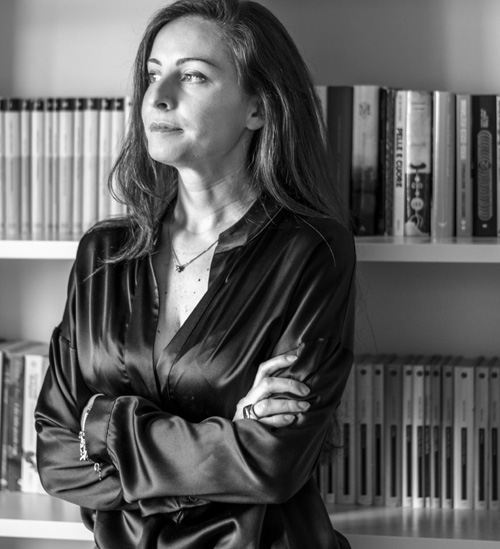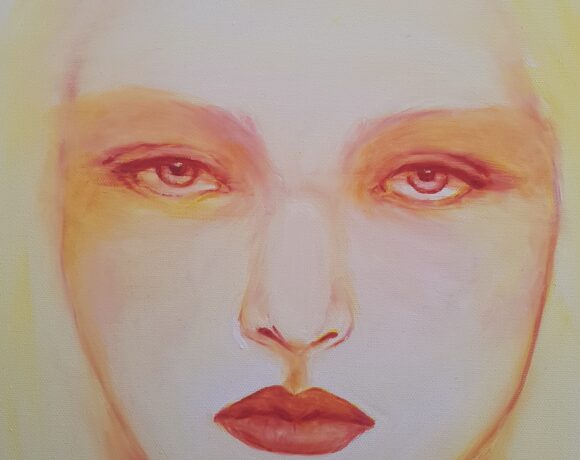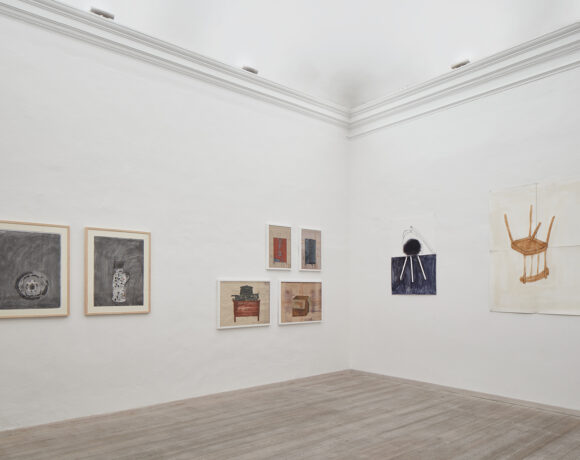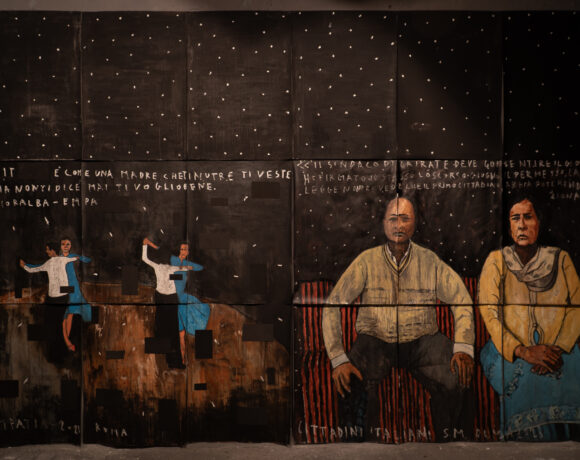In semiotics, there is an atypical yet very clear explanation of the term symbolic, described as the image of a wave beating against the shore of a beach. The wave, repeatedly renewing its appearance, unfolds into various meanings through revelation[1]. This process is a fusion of visual and written elements, which, presenting themselves to the collective memory in an unusual manner, capture our attention and stimulate a free analysis. This interpretation is revelatory in nature, as the symbolic image unfolds through a process of variation, referring to specific emergences from one’s visual culture.

Rinus Van de Velde, “I am done singing about the past”, installation view, courtesy Tim Van Laere Gallery, Antwerp-Rome
This characterizes the drawing of Rinus Van de Velde (1983, Leuven, Belgium), whose works, with their distinct and specific references to the iconographies of art history, can be interpreted through a play of appearances, thus creating a lively space for questioning. However, the doubts that arise do not belong to the observer; rather, it is the symbolic nature of the work that surprises us with its open and clear dialogue, almost disorienting, with its iconographic source. The project titled I am done singing about the past by the artist, currently on display at the Tim Van Laere Gallery in Rome, although a result of study on the past, presents no form of nostalgia. Furthermore, besides being an act of reappropriation and mastery over certain iconographic sources, the exhibition reflects the construction of a transitive relationship between the word, intimately connected to representation, and the collective cultural memory.

Rinus Van de Velde, “Our nights suddenly became our days”, 2023, oil pastel on paper, 89,5 x 126,5 x 4 cm, courtesy Tim Van Laere Gallery, Antwerp-Rome
Thus, it is natural for the artist to view the work as an exercise in interpretation, where the normal pictorial language is decoded in the carefully achieved balance within the suggestive interference between image and written word. Van de Velde’s intent is to stimulate an interpretative reading in the viewer, playing precisely on the relationship between the reciprocity of the ideogram and iconic figuration. The final work results in a visual system composed of various parts, all marked by a clear distinction between verbal language and image. Consequently, each piece on display demands an internal contemplation, an approach to both linguistics and painting, serving as the conception of a mental narrative. According to this interpretation, artist’s works impress with their use of a changing, atypical, eclectic technique that unites all the pieces in the exhibition, while remaining recognizable but difficult to describe. However, the artist is always consistent in working with the quintessential collector of intimate memories, the paper medium, from which spontaneously balanced works emerge due to naturalism.

Rinus Van de Velde, “I am done singing about the past”, 2023, oil pastel on paper, 89,5 x 103,5 x 4 cm, courtesy Tim Van Laere Gallery, Antwerp-Rome
Van de Velde thus favors a figurative objectivity as faithful to reality as possible, always on the edge of an anticipation horizon, which is resolved in the relationship between word and image, also stimulating new observations. Yet, upon viewing the works on display, a methodical and well-structured hand is evident, setting up scenes with deliberately characteristic perspectives, like captivating photographic angles, sometimes flattened or otherwise opened up. This brings forth another aspect of Van de Velde’s works: the strongly picturesque quality. This refers to the value attributed to tones and colors, previously avoided in favor of using only charcoal in past explorations. Technical choices are arranged according to a natural disorder and irregularity, aimed at depicting a free, improvised and vividly descriptive pictorial meditation. Thus, the lines in some points are thin and nervous, while in others they are broad and expansive, as all the works touch upon the fundamental issues of painting, namely verisimilitude and the sense of narration.

Rinus Van de Velde, “Cy, Cy, Cy, …”, 2023, colored pencil on paper, 43,5 x 50 x 4 cm, courtesy Tim Van Laere Gallery, Antwerp-Rome
This topic is particularly dear to the artist, as it is addressed in the video A Life in a Day (2021 – 2023), which narrates the daily routine of an apparently ordinary character fantastically portrayed by the artist himself. The fragments of the film best elucidate the derivation of the sculpture set up in the center of the gallery, depicting an agave tree, confirming how for Van de Velde, art is a medium for bringing to light the unspoken, imbued with a strong sense of mystery. Regarding the ability to make the figurative dialogue with the written text, in all his works, a natural predominance of the former over the latter is evident. It is worth asking whether the choice is the result of an image of a story or otherwise the written and captioned narrative of specific episodes. It becomes unequivocally clear that the sole aim is to accompany or otherwise stimulate the reader-viewer in the simplest way: using immediate and easily decipherable words.

Rinus Van de Velde, “Every day before dawn”, 2024, charcoal on canvas, 164 x 231 x 5 cm, courtesy Tim Van Laere Gallery, Antwerp-Rome
At this point, it is confirmed that Van de Velde’s effort is not directed towards the script, instead privileging the vivid prominence of the images, confirming that, according to his thinking, the work’s heart lies in the painted scene. Thus, the exhibition reveals an artist who is predictable in relation to the narrative, as the space of figuration is always the natural overall vision of the exhibition project, positioning itself as the place where image notes take shape. It would not be wrong then to consider the works as a mental theater, a daily and inner stage where creativity is captured in an act of total freedom, and where the transposition of a scene, painted in his studio, assumes expressive form after iconographic research aimed at the less imponderable artistic forms.

Rinus Van de Velde, “I am done singing about the past”, installation view, courtesy Tim Van Laere Gallery, Antwerp-Rome
For these reasons, Rinus Van de Velde’s works should be considered as they appear: glimpsed scenarios from a pleasant viewpoint that address both the narrative aspect of painting and the dynamics of the relationship between image and written text. Additionally, the underlying annotations do not develop an autonomous life; they require the support of the vibrant reference scenes, laden with symbolic character, allowing us to approach an already-lived chronicle while maintaining a specific stylistic identity. Lastly, it is evident how the artist favors the narrative aspect, carried out with a plurality of visual rhythms where the issues of the symbolic and the picturesque touch upon each other without ever being exhausted. Instead, they open to stimulating questions to be deciphered and interpreted.
Maria Vittoria Pinotti
[1] Umberto Galiberti, L’esegesi simbolica, in Il gioco delle opinioni, Universale Economica Feltrinelli, 2019, pp. 58-59
Info:
Rinus Van De Velde. I am done singing about the past
Tim Van Laere Gallery Rome
04/05/2024 – 06/07/2024
From Tuesday to Saturday from 1.00 pm to 6.00 pm
www.timvanlaeregallery.com
Palazzo Donarelli Ricci, Via Giulia 98, 00186 Roma
info@timvanlaeregallery.com | 06 97 603 423

Maria Vittoria Pinotti (1986, San Benedetto del Tronto) is an art historian, author, and independent critic. She currently is the coordinator of Claudio Abate’s photographic archive and Manager at Elena Bellantoni’s Studio. From 2016 to 2023 she was the Gallery Manager in a gallery in the historic center of Rome. She has worked with ministerial offices such as the General Secretariat of the Ministry of Culture and the Central State Archive. Currently, she collaborates with cultural sector magazines, focusing on in-depth thematic studies dedicated to modern and contemporary art.






NO COMMENT